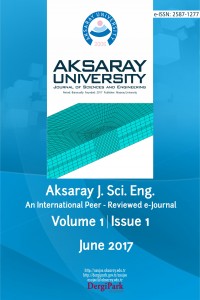Abstract
In this
study, the settlement behavior of Aksifat concrete faced rock-filled dam was
analyzed, during both period of construction and its water retention. In order to determine
total displacement and stress distribution, two-dimensional strain analyses were
performed using PLAXIS program based on the finite elements method. The
material parameters of the dam were obtained from geotechnical reports,
literature studies and the well logging data carried out within the scope of
the project. The linear elastic material model was preferred for the bedrock in
dam modelling, while the Mohr-Coulomb (MC) model was used for the rock fill,
rock foundation and filter sand-gravel. Considering the seismotectonic features
of the dam site, the Mw 5.7 Upland California earthquake with a
maximum acceleration value of 0.24 g was utilized in the dynamic analysis. In the
static analysis, the maximum settlement value was observed in the middle of the
dam body fill and in the crest. The maximum value of settlement was computed at
the top of the dam body. According to slope stability analysis; the static
slope safety factor is greater than 2.0 which indicates that the slope
stability is in balance. In the dynamic case, the value of the safety factor is
reduced to the value of 1.3. This result indicates that the slope is in
equilibrium whereas the slope stability tends to decline if the earthquake acceleration value
increases. In terms of 2D deformations and the state of slope stability under
seismic forces; the Mw 5.7 earthquake with a maximum acceleration
value of 2.4 g will not produce any risk based on the finite element model of the
dam used in this study.
Keywords
finite elements method slope stability Aksıfat dam static and dynamic analysis slope stability
References
- Bayraktar A., Türker T., Akköse M., Ateş Ş. 2010. The Effect of Reservoir Length on Seismic Performance of Gravity Dams to Near- And Far-Fault Ground Motions. Natural Hazards, 52; 257-275.
- Bell, F., 2004. Engineering geology and construction, British geological survey, spon press, ISBN 0-415-25939-8
- Bishop, A.W. and Morgenstern, Norbert 1960. "Stability Coefficients for Earth Slopes," Geotechnique, Institution of Civil Engineers, London, Vol. 10, No. 4, December, pp. 129-150.
- Chrzanowski, A,S., Massiéra,M., 2004. Modelling of Deformations Durıng Construction of a Large Earth Dam in The La Grande Complex, Technical Sciences, No 7, Canada.
- Cook, R.D., Malkus, D.S. and Plesha, M.E. 1989. Concepts and Applications of Finite Element Analysis, 3rd edition, John Wiley & Sons, New York, NY.
- Çalamak, M., Selamoğlu, M., Yanmaz, M., A., 2015. Toprak dolgu barajlarda hazne seviyesindeki ani düşmenin şev stabilitesine etkilerinin değerlendirilmesi, Su yapıları konferansı, Doi:10.13140/RG.2.1.2084.7448.
- DSI, 2015. The general directorate of state hydraulic works, official statistical reports, http://www.dsi.gov.tr/dsi-resmi-istatistikler.
- Dusseault vd., 1991. Rock Engineering Applications, McGraw-Hill Publications, ISBN 10:0070218897.
- Houqun, C., Wu, S., Dang, F., 2015. Seismic safety of high arch dams, Elsevier publications, ISBN: 978-0-12-803628-0.
- ICOLD, (2004). International commission on large dams reports, http://www.icold-cigb.org/GB/publications/bulletins.asp
- Krahn, J., 2004. Stability modelling with SLOPE/W, printed in Canada.
- Lane P. A. and Griffiths, D. V., 2000. Assessment of stability of slopes under drawdown conditions, Journal of Geotechnical and Geoenvironmental Engineering, doi: 10.1061/(ASCE)1090-0241(2000)126:5(443).
- Lia M.C., Guoa X.Y., Shib J., Zhua Z.B. 2015. Seepage and stress analysis of anti-seepage structures constructed with different concrete materials in an RCC gravity dam. Water Science and Engineering, 8(4); 326-334.
- Morgenstern, N.R., and Price, V.E., 1965. The Analysis of the Stability of General Slip Surfaces. Geotechnique, Vol. 15, pp. 79-93.
- Özkuzukıran, R. S., 2005. Settlement Behaviour of Concrete Faced Rockfill Dams: A Case Study, MSc Thesis in Civil Engineering, METU.
- Reilinger, R., et al., 2006. GPS constraints on continental deformation in the Africa-Arabia-Eurasia continental collision zone and implications for the dynamics of plate interactions, J. Geophys. Res., 111, B05411, doi:10.1029/ 2005JB004051.
- Schleiss, A. J. and Boes, R. M., 2011. Dams and reservoir under changing challenges, CRC press, ISBN 9780415682671.
- USGS, 2016, Strong-motion recordings from the ML=5.5 Upland, California earthquake of February 28, 1990, open-file report 90-311, https://pubs.er.usgs.gov/publication/ofr90311.
- Woessner vd., 2015. The 2013 European seismic hazard model: key components and results, Bulletin of Earthquake Engineering, V:13(12), p:3553-3596.
- Yeow vd., 2016. Wall building stiffness and strength effect on content sliding in Wellington seismic conditions, Earthquake Eng&Structural dynamics, doi:10,1002/ege.2843.
- Zhang J., He. J., Fan, J., 2001. Static and dynamic stability assessment of slopes or dam foundations using a rigid body-spring element method, International Journal of Rock Mechanics and Mining Sciences, V:38(8), p:1081-1090.
- Zienkiewicz, O. C. and Taylor, R. L. 1989. The Finite Element Method, 4th edition, Vol. 1: Basic Formulation and Linear Problems, McGraw‐Hill, New York.
Abstract
Bu çalışmada ön yüzü beton kaplı kaya dolgu baraj
olan Aksıfat Barajının inşa aşamasında ve su tutma aşamalarındaki oturma
davranışı incelenmiştir. Toplam yer değiştirme ve gerilme dağılımları
belirlenmesi amacıyla sonlu elemanlara dayalı PLAXIS programı kullanılarak iki
boyutlu düzlemsel şekil değiştirme analizleri yapılmıştır. Barajı oluşturan
malzemelere ait parametreler, proje kapsamında yapılan araştırma kuyu kesit
verilerinde, geoteknik raporlardan ve literatür çalışmalarından elde
edilmiştir. Baraj modelinde ana kaya için lineer elastik malzeme modeli; kaya
dolgu, kaya temel ve filtre kum-çakıl için Mohr-Coulomb (MC) modelleri tercih
edilmiştir. Baraj ile birlikte temel zemininde davranışının modellenmesi için
zemin formasyonları da sonlu elemanlar modeline dahil edilmiştir. Statik çözüm
için barajın kendi ağırlığı altında oluşan yer değiştirme ve gerilme analizleri
yapılmıştır. Barajın yer aldığı bölgenin sismotektoniği
dikkate alınarak, 0.24 g maksimum ivme değerine sahip Mw
5.7 Upland Kaliforniya depremi dinamik analizlerde kullanılmıştır. Statik durum
analizinde maksimum oturma değeri baraj gövde dolgusunun ortalarında ve krette
oluştuğu gözlemlenmiştir. Baraj gövdesi içerisinde hesaplanan maksimum oturma,
baraj gövde ortasının en üst noktasında elde edilmiştir. Şev stabilite
analizlerine göre; statik durumda elde edilen şev güvenlik katsayısı 2.0 dan
büyüktür ve bu durum şevin dengede olduğunu göstermektedir. Dinamik durumda ise
elde edilen güvenlik katsayıları değerleri düşerek 1.3 civarında elde edilmiştir.
Bu durum şevin dengede olduğunu ancak deprem ivme değerinde artış olması
durumunda şev dengesinin bozulma eğiliminde olduğunu göstermektedir. Sismik
kuvvetler altında iki boyutta yer değiştirmeler ve şev stabilitesi
değerlendirildiğinde inceleme bölgesinde 0.24 g ivmeli Mw 5.7
büyüklüğünde bir depremin oluşması halinde incelenen barajın sonlu eleman modelinde risk oluşturacak boyutta
deformasyonlar meydana gelmesi öngörülmemektedir.
References
- Bayraktar A., Türker T., Akköse M., Ateş Ş. 2010. The Effect of Reservoir Length on Seismic Performance of Gravity Dams to Near- And Far-Fault Ground Motions. Natural Hazards, 52; 257-275.
- Bell, F., 2004. Engineering geology and construction, British geological survey, spon press, ISBN 0-415-25939-8
- Bishop, A.W. and Morgenstern, Norbert 1960. "Stability Coefficients for Earth Slopes," Geotechnique, Institution of Civil Engineers, London, Vol. 10, No. 4, December, pp. 129-150.
- Chrzanowski, A,S., Massiéra,M., 2004. Modelling of Deformations Durıng Construction of a Large Earth Dam in The La Grande Complex, Technical Sciences, No 7, Canada.
- Cook, R.D., Malkus, D.S. and Plesha, M.E. 1989. Concepts and Applications of Finite Element Analysis, 3rd edition, John Wiley & Sons, New York, NY.
- Çalamak, M., Selamoğlu, M., Yanmaz, M., A., 2015. Toprak dolgu barajlarda hazne seviyesindeki ani düşmenin şev stabilitesine etkilerinin değerlendirilmesi, Su yapıları konferansı, Doi:10.13140/RG.2.1.2084.7448.
- DSI, 2015. The general directorate of state hydraulic works, official statistical reports, http://www.dsi.gov.tr/dsi-resmi-istatistikler.
- Dusseault vd., 1991. Rock Engineering Applications, McGraw-Hill Publications, ISBN 10:0070218897.
- Houqun, C., Wu, S., Dang, F., 2015. Seismic safety of high arch dams, Elsevier publications, ISBN: 978-0-12-803628-0.
- ICOLD, (2004). International commission on large dams reports, http://www.icold-cigb.org/GB/publications/bulletins.asp
- Krahn, J., 2004. Stability modelling with SLOPE/W, printed in Canada.
- Lane P. A. and Griffiths, D. V., 2000. Assessment of stability of slopes under drawdown conditions, Journal of Geotechnical and Geoenvironmental Engineering, doi: 10.1061/(ASCE)1090-0241(2000)126:5(443).
- Lia M.C., Guoa X.Y., Shib J., Zhua Z.B. 2015. Seepage and stress analysis of anti-seepage structures constructed with different concrete materials in an RCC gravity dam. Water Science and Engineering, 8(4); 326-334.
- Morgenstern, N.R., and Price, V.E., 1965. The Analysis of the Stability of General Slip Surfaces. Geotechnique, Vol. 15, pp. 79-93.
- Özkuzukıran, R. S., 2005. Settlement Behaviour of Concrete Faced Rockfill Dams: A Case Study, MSc Thesis in Civil Engineering, METU.
- Reilinger, R., et al., 2006. GPS constraints on continental deformation in the Africa-Arabia-Eurasia continental collision zone and implications for the dynamics of plate interactions, J. Geophys. Res., 111, B05411, doi:10.1029/ 2005JB004051.
- Schleiss, A. J. and Boes, R. M., 2011. Dams and reservoir under changing challenges, CRC press, ISBN 9780415682671.
- USGS, 2016, Strong-motion recordings from the ML=5.5 Upland, California earthquake of February 28, 1990, open-file report 90-311, https://pubs.er.usgs.gov/publication/ofr90311.
- Woessner vd., 2015. The 2013 European seismic hazard model: key components and results, Bulletin of Earthquake Engineering, V:13(12), p:3553-3596.
- Yeow vd., 2016. Wall building stiffness and strength effect on content sliding in Wellington seismic conditions, Earthquake Eng&Structural dynamics, doi:10,1002/ege.2843.
- Zhang J., He. J., Fan, J., 2001. Static and dynamic stability assessment of slopes or dam foundations using a rigid body-spring element method, International Journal of Rock Mechanics and Mining Sciences, V:38(8), p:1081-1090.
- Zienkiewicz, O. C. and Taylor, R. L. 1989. The Finite Element Method, 4th edition, Vol. 1: Basic Formulation and Linear Problems, McGraw‐Hill, New York.
Details
| Subjects | Engineering |
|---|---|
| Journal Section | Research Article |
| Authors | |
| Publication Date | April 21, 2017 |
| Submission Date | March 15, 2017 |
| Acceptance Date | April 18, 2017 |
| Published in Issue | Year 2017 Volume: 1 Issue: 1 |
Aksaray J. Sci. Eng. | e-ISSN: 2587-1277 | Period: Biannually | Founded: 2017 | Publisher: Aksaray University | https://asujse.aksaray.edu.tr
ASUJSE is indexing&Archiving in










